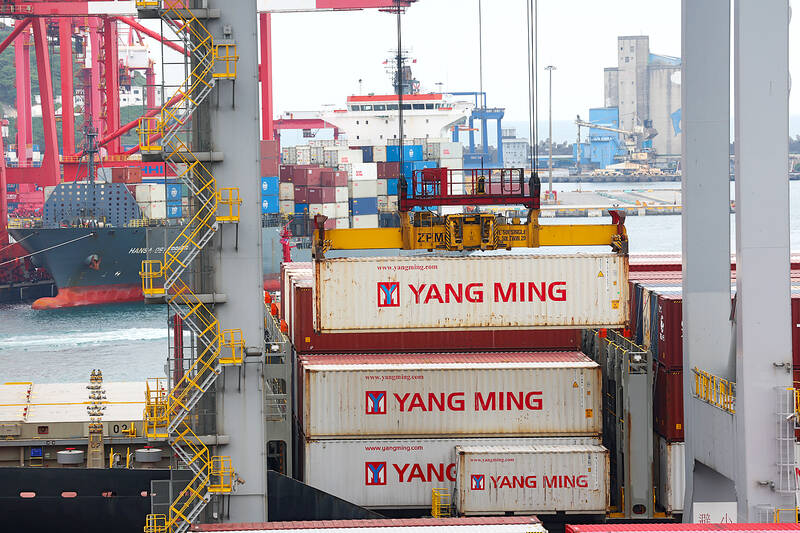Taiwan’s exports last month grew 9.2 percent from a year earlier to the second highest for a single month at US$43.59 billion, with expansion in almost all product categories, as global customers built inventory ahead of the Lunar New Year and potential tariff hikes, the Ministry of Finance said yesterday.
However, the 14-month upswing might come to a pause this month, as firms observe the nine-day Lunar New Year holiday weighing on shipments that might decline 1 to 4 percent year-on-year, Department of Statistics Director-General Beatrice Tsai (蔡美娜) said.
It is better to combine the data of January and February to gain a better understanding of real export performance, she said.

Photo: CNA
Exports in the fourth quarter of last year expanded 9.1 percent to US$125.97 billion, while exports for the whole of last year increased 9.9 percent to US$475.07 billion, both stronger than the projections in November last year by the Directorate-General of Budget, Accounting and Statistics, Tsai said.
Insatiable demand for electronics used in artificial intelligence (AI) development continued to provide business orders for local firms making chips, servers and other devices regardless of seasonality, Tsai said.
In particular, shipments of information and communications products rose 16 percent last month, 18.5 percent last quarter and 59 percent last year, the ministry’s report said.
The uptick definitely had to do with the high sales season, but some likely stemmed from rush orders intended to evade potential tariff hikes, Tsai said.
US president-elect Donald Trump has threatened to raise tariffs on all imports after his inauguration on Jan. 20, propelling shipments bound for resale in the US market before their schedule, she said.
That helped explain why exports of base metals, plastic, chemical, mineral and textile products also reported improvement, Tsai said.
Shipments of non-tech products have taken a hit from a supply glut amid listless demand in China and Europe, underlying Taiwan’s uneven recovery, Tsai said, adding that the low base last year helped fuel restocking.
Against this backdrop, Taiwan’s trade with China and Europe is losing steam, while gaining traction with the US and Southeast Asia, Tsai said.
Imports, a critical measure of exports and investment interest on the part of local firms, recorded a sharp annual increase of 30.4 percent to US$37.51 billion last month as imports of capital equipment surged 48.7 percent and semiconductor equipment advanced 53 percent from their levels the year before, the report said.
The data suggested that private investment would become a major GDP growth driver in the last quarter and beyond, Tsai said.
Taiwan recorded a trade surplus of US$6.08 billion last month, representing a 45.5 percent decline from a year earlier, the ministry said.
For the whole of last year, the trade surplus amounted to US$80.61 billion, a tiny 0.2 percent retreat annually.

Taiwan Semiconductor Manufacturing Co (TSMC, 台積電) last week recorded an increase in the number of shareholders to the highest in almost eight months, despite its share price falling 3.38 percent from the previous week, Taiwan Stock Exchange data released on Saturday showed. As of Friday, TSMC had 1.88 million shareholders, the most since the week of April 25 and an increase of 31,870 from the previous week, the data showed. The number of shareholders jumped despite a drop of NT$50 (US$1.59), or 3.38 percent, in TSMC’s share price from a week earlier to NT$1,430, as investors took profits from their earlier gains

In a high-security Shenzhen laboratory, Chinese scientists have built what Washington has spent years trying to prevent: a prototype of a machine capable of producing the cutting-edge semiconductor chips that power artificial intelligence (AI), smartphones and weapons central to Western military dominance, Reuters has learned. Completed early this year and undergoing testing, the prototype fills nearly an entire factory floor. It was built by a team of former engineers from Dutch semiconductor giant ASML who reverse-engineered the company’s extreme ultraviolet lithography (EUV) machines, according to two people with knowledge of the project. EUV machines sit at the heart of a technological Cold

Taiwan’s long-term economic competitiveness will hinge not only on national champions like Taiwan Semiconductor Manufacturing Co. (TSMC, 台積電) but also on the widespread adoption of artificial intelligence (AI) and other emerging technologies, a US-based scholar has said. At a lecture in Taipei on Tuesday, Jeffrey Ding, assistant professor of political science at the George Washington University and author of "Technology and the Rise of Great Powers," argued that historical experience shows that general-purpose technologies (GPTs) — such as electricity, computers and now AI — shape long-term economic advantages through their diffusion across the broader economy. "What really matters is not who pioneers

TAIWAN VALUE CHAIN: Foxtron is to fully own Luxgen following the transaction and it plans to launch a new electric model, the Foxtron Bria, in Taiwan next year Yulon Motor Co (裕隆汽車) yesterday said that its board of directors approved the disposal of its electric vehicle (EV) unit, Luxgen Motor Co (納智捷汽車), to Foxtron Vehicle Technologies Co (鴻華先進) for NT$787.6 million (US$24.98 million). Foxtron, a half-half joint venture between Yulon affiliate Hua-Chuang Automobile Information Technical Center Co (華創車電) and Hon Hai Precision Industry Co (鴻海精密), expects to wrap up the deal in the first quarter of next year. Foxtron would fully own Luxgen following the transaction, including five car distributing companies, outlets and all employees. The deal is subject to the approval of the Fair Trade Commission, Foxtron said. “Foxtron will be